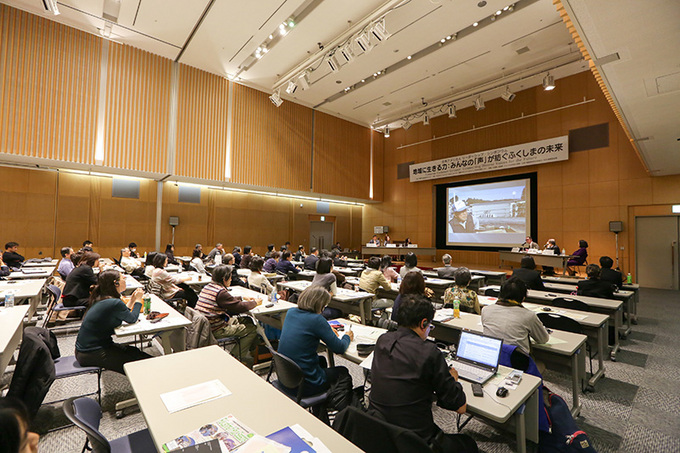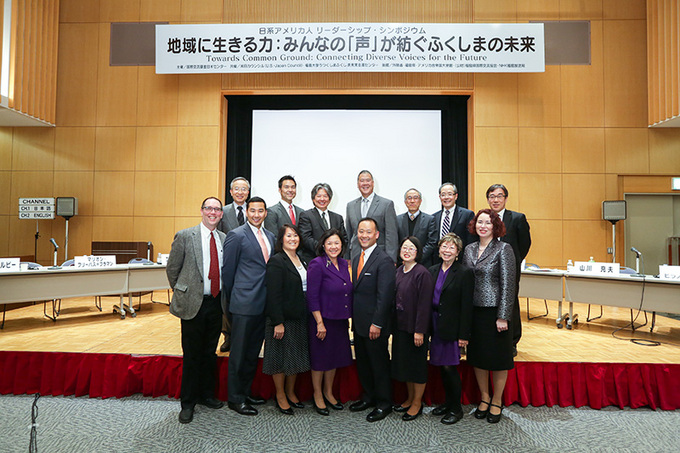Sharing "Voices" of Fukushima with the Young Japanese American Leaders
Irene Hirano Inouye
President, U.S.-Japan Council
On the second anniversary of the Great East Japan Earthquake and tsunami, the 2013 Japanese American Leadership Delegation (JALD) was in Fukushima, Japan. This annual program, co-organized by the Ministry of Foreign Affairs of Japan and the U.S.-Japan Council brings Japanese Americans to Japan to build people-to-people connections with Japanese leaders from all sectors of society.
A total of 163 Japanese American leaders from throughout the United States have participated in the program since it began in the year 2000. The delegates meet with top Japanese leaders including the Prime Minister, Foreign Minister, corporate CEOs and civil society professionals. U.S.-Japan Council President Irene Hirano Inouye has traveled with all thirteen delegations.
The 2011 JALD was in Tokyo on March 11, 2011 when the Great East Japan Earthquake struck and in 2012, the delegates visited Sendai and Ishinomaki. It was especially meaningful for the delegation to be in Fukushima on the second anniversary of the disasters. From seniors to school children, the delegates learned about the recovery efforts in Fukushima and were inspired by the resilience and spirit of the people there. Every visit while in Fukushima reflected the sentiment that people want to share their experiences with the world so that others can benefit from lessons learned during the aftermath. Japanese Americans understand the importance of sharing one's story in order to find common ground as the first step to building enduring people-to-people and country-to-country connections.
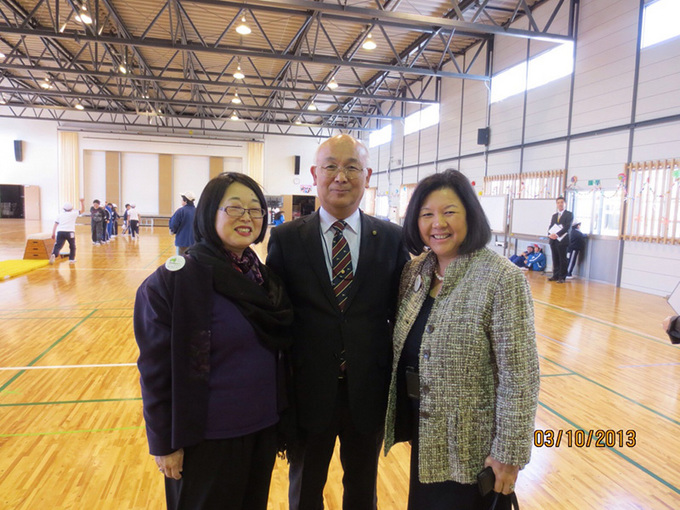
At the gymnasium of the temporary school building shared with Kusano Elementary School, Iitoi Elementary School, and Usuishi Elementary School in Iitate Village
From left: The JALD participant Dr. Emily Murase, Mr. Kaname Hirose, the head of the Iitate's board of education, and the writer
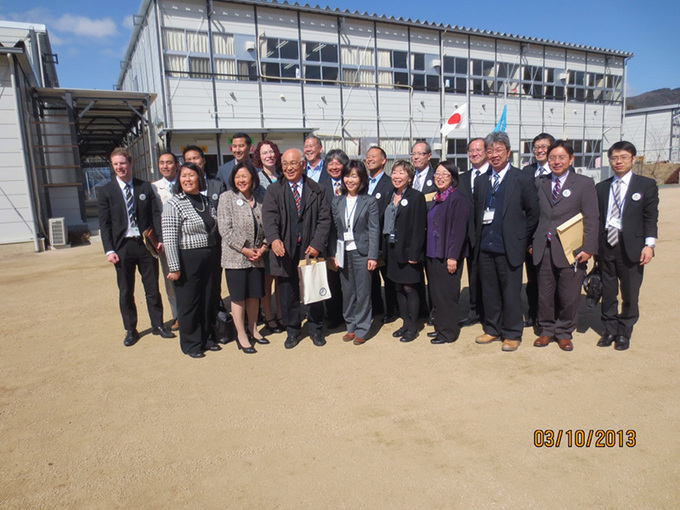
At the temporary school building shared with Kusano Elementary School, Iitoi Elementary School, and Usuishi Elementary School in Iitate Village
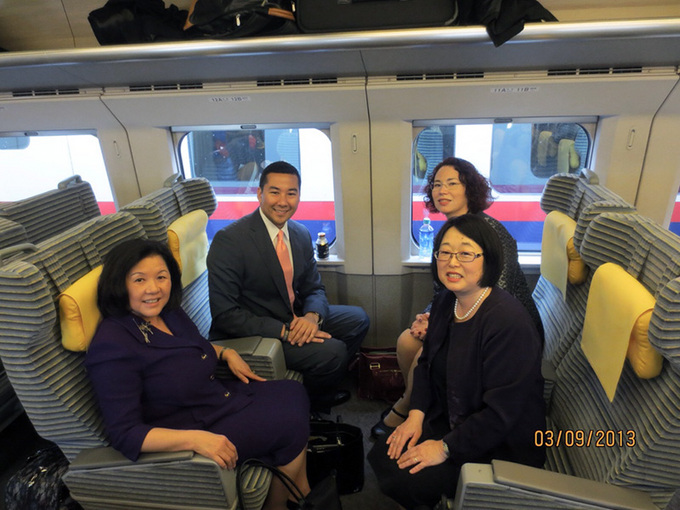
In a bullet train heading to Fukushima
From left , clockwise: the writer, Mr. Kelly Ogilvie, Dr. Marion Friebus-Flaman, and Dr. Emily Murase,
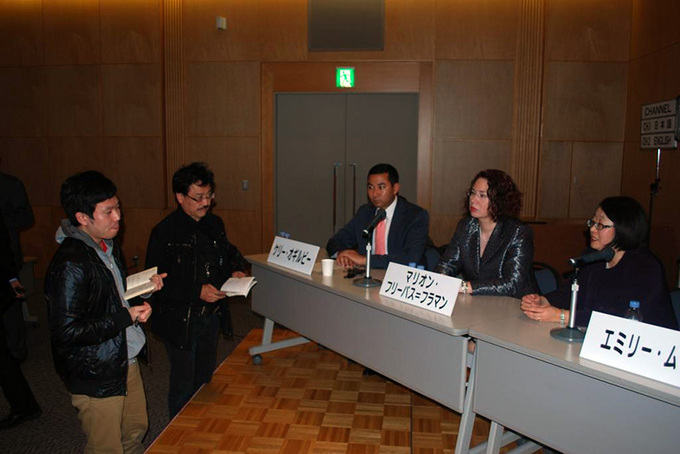
The panelists having a press interview at the symposium
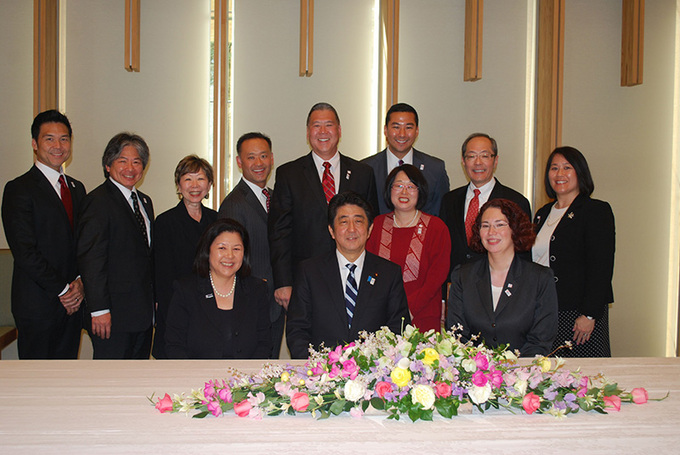
Paying a courtesy call on Prime Minister Abe (March 15, 2013)
*For more details on this visit, please see the Prime Minister's Office website.
The role that Japanese Americans can play in U.S.-Japan relations
The history of Japanese Americans includes the World War II experience, when more than 120,000 Japanese Americans were forced by the United States Government to leave their homes and become incarcerated behind barbed wire. The World War II experience also includes the heroism and valor of Japanese Americans who served with distinction in the military in the segregated units of the 442nd Regimental Combat Team, the 100th Infantry Battalion and the Military Intelligence Service. Japanese Americans rarely spoke of their experiences during World War II until the 1960's and 1970's when the Sansei generation began asking questions about what happened during the war. The Sansei encouraged the Issei and the Nisei to talk about what had happened and its impact. These first-hand stories of the injustices endured by Japanese Americans coupled with the advocacy of Japanese Americans in the 1980's led to the passage of the historic 1988 Civil Liberties Act, which included a presidential apology and token reparations. The importance of preserving and sharing personal stories has become a vital part of Japanese American society.
World War II played a major role in severing ties between Japanese Americans and Japan. As a result, the connections between Japanese and Japanese Americans are complex. Today's opportunities for collaboration and mutual benefit are great and demand a renewed commitment to involving Japanese Americans in U.S.-Japan relations. The JALD program has provided Japanese American leaders with the opportunity to become acquainted or re-engaged with Japan. During the trip, delegates participate in discussions related to the role that Japanese Americans can play in addressing key issues facing both countries, now and in the future.
Visiting Fukushima in the year that marks the second anniversary of the 2011 earthquake
As a part of the Fukushima visit, the Japan Foundation Center for Global Partnership (CGP), the U.S.-Japan Council, and Fukushima Future Center for Regional Revitalization, Fukushima University (FURE) co-hosted a symposium titled: "Towards Common Ground: Connecting Diverse Voices for the Future." Three members of the 2013 Japanese American Leadership Delegation served as panelists. The symposium on March 10, 2013 brought together a diverse audience of students, local residents, public officials and members of the media. Opening remarks for the symposium were provided by Mr. Eiji Taguchi, Executive Vice President of the Japan Foundation, and Mr. Fumio Murata, Vice Governor of Fukushima Prefecture.
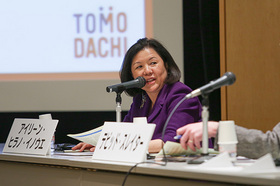 I provided a brief introduction, describing the U.S.-Japan Council, the Japanese American Leadership Delegation and the TOMODACHI initiative. TOMODACHI is a public-private partnership between the U.S.-Japan Council and the U.S. Embassy in Tokyo with the support of the Government of Japan, corporations, organizations and individuals from the United States and Japan. TOMODACHI supports Japan's recovery from the Great East Japan Earthquake, and invests in the next generation of Japanese and Americans in ways that strengthen cultural and economic ties, and deepen the friendship between the United States and Japan over the long-term.
I provided a brief introduction, describing the U.S.-Japan Council, the Japanese American Leadership Delegation and the TOMODACHI initiative. TOMODACHI is a public-private partnership between the U.S.-Japan Council and the U.S. Embassy in Tokyo with the support of the Government of Japan, corporations, organizations and individuals from the United States and Japan. TOMODACHI supports Japan's recovery from the Great East Japan Earthquake, and invests in the next generation of Japanese and Americans in ways that strengthen cultural and economic ties, and deepen the friendship between the United States and Japan over the long-term.
Overcoming adversity and challenges
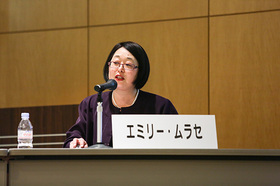 The first of the three JALD presenters was Dr. Emily Murase, who serves as Executive Director of the San Francisco Department on the Status of Women. Additionally, in 2010 Dr. Murase became the first Japanese American elected to the San Francisco Board of Education. Her presentation was titled "Home, Community, Change: What Will Your Adventure Be." Her talk explored her Japanese American origins and her family role models.
The first of the three JALD presenters was Dr. Emily Murase, who serves as Executive Director of the San Francisco Department on the Status of Women. Additionally, in 2010 Dr. Murase became the first Japanese American elected to the San Francisco Board of Education. Her presentation was titled "Home, Community, Change: What Will Your Adventure Be." Her talk explored her Japanese American origins and her family role models.
"My grandparents were from Yamaguchi Prefecture and came to the United States in the early 1900's to work on the grape farms of California. They were not wealthy, but they saved every penny and purchased a small grape farm by 1940.
.....President Franklin Roosevelt's Executive Order 9066, issued in February 1942, which required my father's family to abandon their farm and board a train to an unknown destination with only what they could carry........Poston Prison Camp in Arizona, was where my father's family was sent......However, my father only stayed a year or so. In 1952, he became the first American to study in Japan as a Fulbright Scholar.
My mother comes from a large family in Aomori, Towada City. My grandfather was in the Japanese Navy and made sure that all of the girls in the family attended college. My mother graduated from Japan Women's University in 1953, and received a scholarship to study in the United States. She came by ship in 1958 to go to school at the University of Pennsylvania where she studied social work."
She then explored the notion of community and how shared culture brings people together and provides a sense of common ground. She concluded by stating that adversity and challenges bring opportunities for new life adventures.
Japanese Americans becoming more diverse
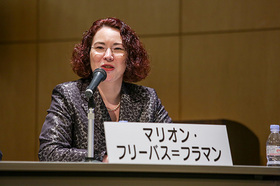 The second presenter was Dr. Marion Friebus-Flaman, Principal of Thomas Dooley Elementary School in Schaumburg, IL. She has participated in the planning and development of a Japanese-English Dual Language Program at the school, where half the students are native speakers of Japanese and half are native speakers of English. Her talk was titled "Building Common Ground."
The second presenter was Dr. Marion Friebus-Flaman, Principal of Thomas Dooley Elementary School in Schaumburg, IL. She has participated in the planning and development of a Japanese-English Dual Language Program at the school, where half the students are native speakers of Japanese and half are native speakers of English. Her talk was titled "Building Common Ground."
"This is a very fitting theme for our panel because, as Japanese Americans, the members of this delegation all come from different places in the United States, have diverse backgrounds and different family histories. Japanese Americans can be Nisei, Sansei, Yonsei, Gosei, or of mixed heritage, like me. We are a diverse group of individuals who have our connections to Japan as our common ground.
My connection to Japan ties me directly to Fukushima. My grandfather, Toshio Kikuchi was a farmer in Fukushima. I remember my grandfather very well. He took me to the strawberry fields and let me help pick the strawberries. Somehow, he always passed over the juiciest strawberries, and I would have to show him what he missed. Of course, I was allowed to eat the strawberries I picked. I never met my grandmother, because she passed away at a young age. My mother told me she was a schoolteacher. I did get to meet my great-grandmother once before we left for the United States. My grandparents lived in an area that is close to Iizaka Onsen. My mother attended Oozasoo Shogakkou."
She then described Dooley Elementary School, which offers a dual-language program that teaches English to Japanese students and Japanese to English speaking students in a blended classroom. The result is bilingual and bicultural competence and true common ground.
Social enterprises launched by "Generation Y"
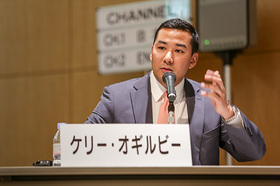 The final delegate to speak was Mr. Kelly Ogilvie, from Seattle, WA. He is the Founder, Chairman, President and Chief Operating Officer of Quemulus, Inc., an "e-wallet" application accessible on the web and mobile devices. He is also Founding Partner of Social Milli, LLC, a social media consultancy that advises small and medium-sized businesses on social media strategy. His talk was titled, "Social Entrepreneurship and the Hero Generation."
The final delegate to speak was Mr. Kelly Ogilvie, from Seattle, WA. He is the Founder, Chairman, President and Chief Operating Officer of Quemulus, Inc., an "e-wallet" application accessible on the web and mobile devices. He is also Founding Partner of Social Milli, LLC, a social media consultancy that advises small and medium-sized businesses on social media strategy. His talk was titled, "Social Entrepreneurship and the Hero Generation."
"I am a Yonsei. My grandfather was a kendo master and artist. I am of mixed heritage, with ancestry in Japan (Hiroshima), Europe, the Philippines and the United States. My grandfather was interned at Tule Lake. To demonstrate his loyalty to the United States, he joined the Army. My father was an entrepreneur, and this had a big impact on me. He started out as a painter, then a carpenter and then he became a manufacturer of buoys. At one point, any buoy on the western coast of the United States was my father's. This entrepreneurial spirit became a part of my upbringing."
Mr. Ogilvie spoke of his background in clean technology, as well as his more recent ventures in the area of social entrepreneurship. He described the Generation Y phenomenon, and noted that Generation Y (those who are 35 and younger) are individuals looking to personally make a difference in the world, and that they are uniquely situated to become the "HERO" generation.
Thinking about the future through the experience of Fukushima
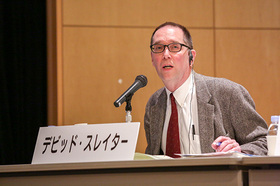 Professor David Slater of Sophia University served as symposium moderator. He provided an introduction about his Tohoku Voices Project, a post-March 11 oral narrative project that gives voice to those most affected by the triple disasters. He shared that the interviews conducted revealed a great deal of resilience and hope in those who lost so much.
Professor David Slater of Sophia University served as symposium moderator. He provided an introduction about his Tohoku Voices Project, a post-March 11 oral narrative project that gives voice to those most affected by the triple disasters. He shared that the interviews conducted revealed a great deal of resilience and hope in those who lost so much.
The final speaker was Professor Mitsuo Yamakawa, Director of Fukushima Future Center for Regional Revitalization (FURE) at Fukushima University. He spoke of his involvement in the recovery process, of the thousands of displaced citizens who want to return to their homes and of the triumph of "human spirit over data." Professor Yamakawa emphasized the need to engage local citizens in reconstruction and noted that 270 volunteers working with FURE provided assistance in developing a radiation map of Fukushima. 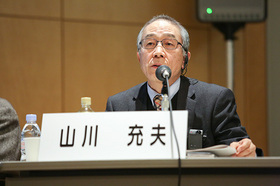
The symposium brought together ideas for the future of Fukushima by giving voice to the people living in the prefecture, and by engaging Japanese and Americans in a constructive and optimistic dialogue about reconstruction and recovery. The Japanese American presenters discussed the importance of preserving and documenting one's stories for future generations and concluded that the opportunity to create "common ground" starts with shared experiences.
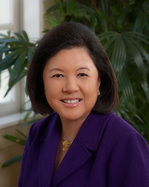 Irene Hirano Inouye
Irene Hirano Inouye
President, U.S.-Japan Council
Irene Hirano Inouye is the former President and the founding CEO of the Japanese American National Museum in Los Angeles, California, which aims to promote the history and experiences of Japanese Americans as part of the American heritage. After 20 years of service to the National Museum, she established the U.S.-Japan Council, a nonprofit organization that brings together leaders from both sides of the Pacific and organizes various exchange programs to strengthen U.S.-Japan relations. She was instrumental in launching the "TOMDACHI Initiative" with the United States and Japanese governments to deepen friendships and nurture the next generation of young people in the two nations for the ongoing support of Japan's recovery from the Great East Japan Earthquake. For many years she has acted as a bridge and contributed greatly to fostering ties between the people of the United States and Japan. She is a recipient of The Japan Foundation Awards 2012, and her husband is the late Senator Daniel Inouye.
The Japanese American leaders who gave the presentations at the symposium
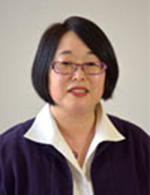 Emily Murase
Emily Murase
Emily Murase serves as Executive Director of the San Francisco Department on the Status of Women, where she oversees a $3.5 million budget to promote the human rights of the women and girls of San Francisco. Previously, she served in the first Clinton White House as Director for International Economic Affairs (1993-1994), after working for AT&T Japan in Tokyo, and she later worked in the International Bureau of the Federal Communications Commission. In 2010, Dr. Murase was elected to the San Francisco Board of Education and is the first Japanese American to serve on the school board. In 2009, Emily was named Woman of the Year by California State Senator Leland Yee and was recognized for her contributions to the women's community by the Democratic Women's Forum. Dr. Murase holds an A.B. in modern Japanese history from Bryn Mawr College (including a year at Tsuda College in Tokyo), a Master's degree from the Graduate School of International Relations & Pacific Studies at UC San Diego, and a Ph.D. in Communication from Stanford. Prefecture in Japan of ancestral origins: paternal side from Yamaguchi, maternal side from Aomori.
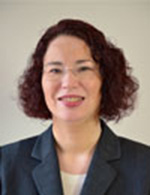 Marion Friebus-Flaman
Marion Friebus-Flaman
Marion Friebus-Flaman is the Principal of Thomas Dooley Elementary School in Schaumburg, IL. She has participated in the planning and development of a Japanese-English Dual Language program at the school, where half the students are native speakers of Japanese and half are native speakers of English. By the time they finish 6th grade, the goal is for each student to be bilingual, bi-literate and bi-cultural. This program is the first of its kind in the U.S. Dr. Friebus-Flaman spent the first six years of her life in Japan, and prior to her time with the Schaumburg School District, she spent six additional years as a foreign lecturer/instructor at two Japanese national universities. She has served as a member of the Illinois English Language Learner Assessment Advisory Committee and the Illinois Governor's Task Force on Growth Models. Dr. Friebus-Flaman holds a B.A. in English from Southern Illinois University at Carbondale, M.A. in TESL from the University of Illinois at Urbana-Champaign, M.S. in Educational Administration from Northern Illinois University and Ph.D. in Education from Capella University. Prefecture in Japan of ancestral origins: Fukushima (maternal grandfather); Kumamoto (maternal grandmother).
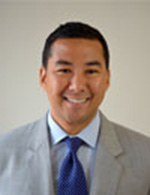 Kelly Ogilvie
Kelly Ogilvie
Kelly Ogilvie is Founder, Chairman, President and Chief Operating Officer of Quemulus, Inc., an "e-wallet" application accessible from a website and mobile devices. He is also Founding Partner of Social Milli, LLC, a social media consultancy that advises small and medium sized businesses on social media strategy. Prior to founding Quemulus and Social Milli, Mr. Ogilvie was Founder, CEO and President of Blue Marble Biomaterials. Before that time, Mr. Ogilvie worked with the Seattle Chamber of Commerce to promote business interests in Washington State, and also worked for Microsoft co-founder Paul Allen's Vulcan Real Estate division on developing the South Lake Union Corridor. He began his career in former Washington State Governor Gary Locke's office coordinating outreach efforts. Mr. Ogilvie also spent time as Deputy Director for former Mayor of Seattle Greg Nickels and currently serves on the Board of Directors of Extraordinary Futures and the External Advisory Board of Washington State University's Center for Environmental Research Education and Outreach. He attended Seattle University, where he received a B.A. in Humanities and International Business. Prefecture in Japan of ancestral origins: unknown.
Keywords
- Politics
- Economics/Industry
- Social Securities/Social Welfare
- Natural Environment
- History
- Cultural Diversity
- Peacebuilding
- Japan
- United States
- U.S.-Japan Council
- Great East Japan Earthquake
- JALD
- Fukushima
- Tokyo
- Sendai
- Ishinomaki
- World War II
- The Japan Foundation Center for Global Partnership
- CGP
- Fukushima University
- Fukushima Future Center for Regional Revitalization
- TOMODACHI initiative
- U.S. Embassy in Tokyo
- San Francisco
- Emily Murase
- Franklin Roosevelt
- Fulbright Scholar
- Japan Women's University
- University of Pennsylvania
- Thomas Dooley Elementary School
- Marion Friebus-Flaman
- Kelly Ogilvie
- e-wallet
- Quemulus
- Social Milli
- Generation Y
- Sophia University
- David Slater
- Mitsuo Yamakawa
Back Issues
- 2022.11. 1 Inner Diversity<3> <…
- 2022.9. 5 Report on the India-…
- 2022.6.24 The 48th Japan Found…
- 2022.6. 7 Beyond Disasters - …
- 2021.3.10 Crossing Borders, En…
- 2020.7.17 A Millennium of Japa…
- 2020.3.23 A Historian Interpre…
- 2019.11.19 Dialogue Driven by S…
- 2019.10. 2 The mediators who bu…
- 2019.6.28 A Look Back at J…


